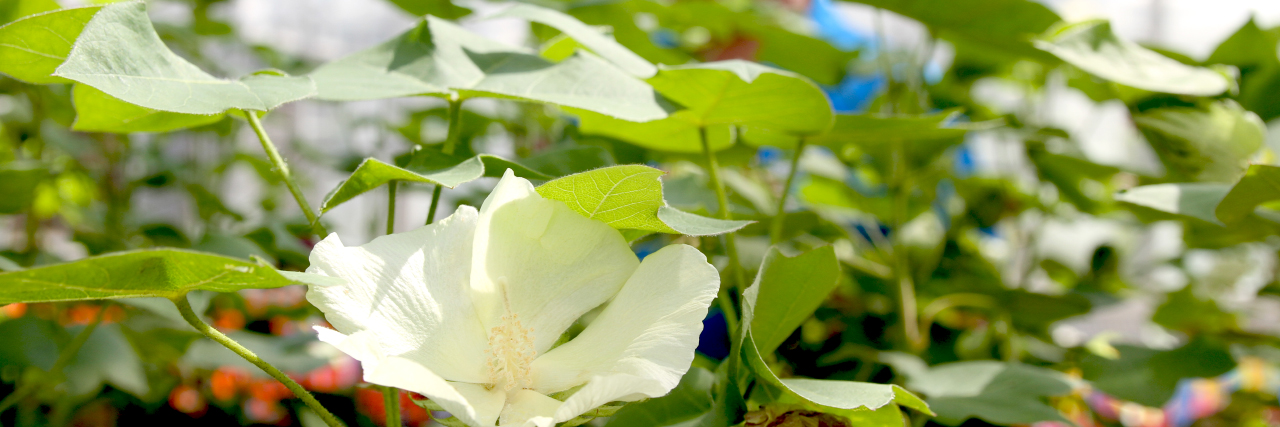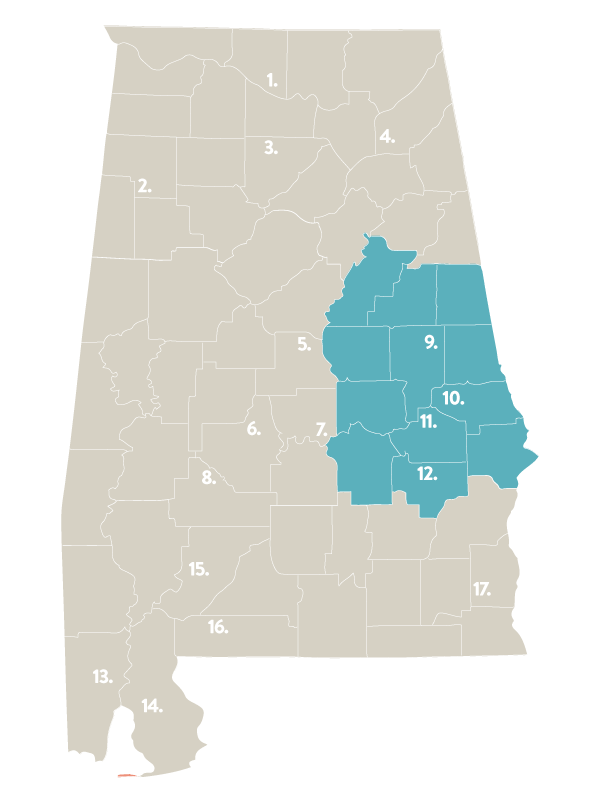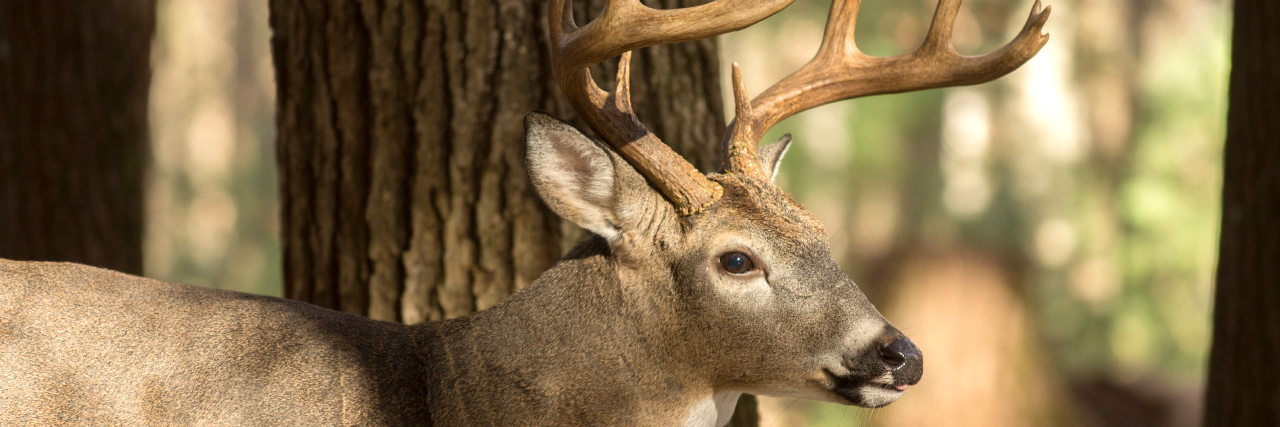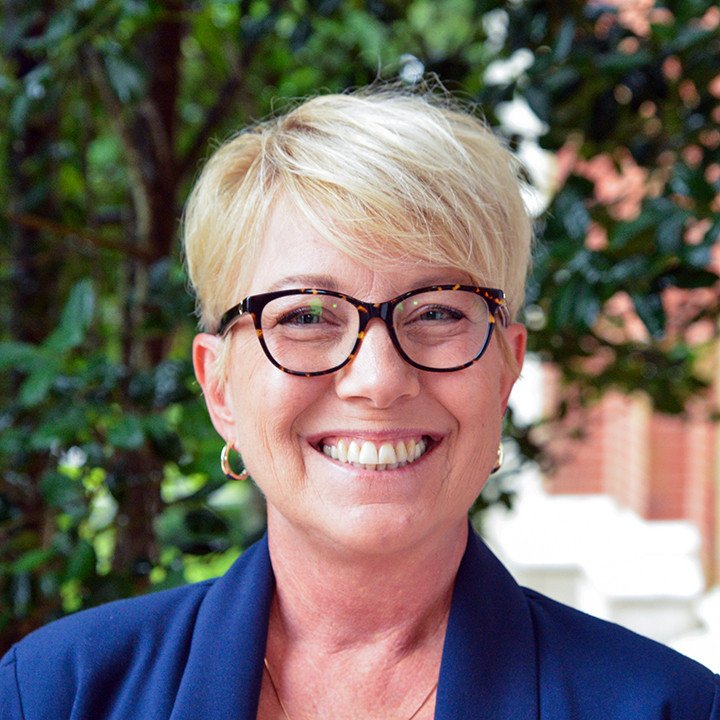
East-Central Region
Alabama Research Units
9. Piedmont Research Unit (PRU)
10. Plant Science Research Center (PSRC)
11. E.V. Smith Research Center (EVSRC)
12. Turnipseed-Ikenberry (T-I)

PIEDMONT RESEARCH Unit
Camp Hill, AL — A four-mile-long, eight-foot-high, fixed-knot steel fence constructed in 2007 at the Piedmont Research Unit in Camp Hill completely encloses 430 of the unit’s acres, and that land plus the deer that were on it when the final section of the fence went up comprise what has been dubbed the Auburn University deer lab. In an exhaustive, multidisciplinary long-term study of the lab’s approximately 100 captive white-tailed herd, researchers will generate detailed information on deer biology and behaviors that is expected to significantly impact the scientific management of deer.

AREAS OF RESEARCH
- WHITE-TAILED DEER – The Piedmont Agricultural Research Unit provides a controlled environment for research on the biology of white-tailed deer. In a long-term study of approximately 100 captive white-tailed deer, researchers are generating detailed information on deer biology and behaviors that is expected to significantly impact the scientific management of deer. The field lab contains a diversity of habitats, including old pastures, hardwood uplands and bottomlands, planted pines and recent clear-cuts that are naturally regenerating.
HISTORY
The Piedmont Research Unit (formerly known as the Piedmont Substation) was established on 1,409 acres in 1945 in Tallapoosa Country near Camp Hill, Ala., to provide additional land for pasture and forage crops research.
The Piedmont Research Unit’s soil types offered opportunities for research to serve a unique farming area and over the years research has been conducted on field, forage and horticultural crop production and beef cattle farming. The substation was the site for a dairy demonstration unit in the 1940s
In the 1990s, results of a 13-year study produced in-depth information about more than 60 native and exotic trees.
Emphasis on wildlife management in more recent years has offered support for landowners interested in cashing in on the strong demand for hunting opportunities. Research over the past 75 years has resulted in the release of six new Chinese chestnut varieties that will yield a continuous high-energy food source for wildlife.
The Piedmont Substation was one of the five substations established in Alabama during and a few years after World War II: Upper Coastal Plain in 1944, Piedmont Substation in 1945, North Alabama Horticulture Substation at Cullman in 1948, Chilton Area Horticulture Substation at Clanton in 1948 and the Lower Coastal Plain Substation at Camden in 1948.
Contact
Piedmont Research Unit
P.O. Box 369
1399 North Main Street
Camp Hill, AL 36850
+1 (256) 896-4422

Jane Farr
Regional Director, East-Central Region
+1 (334) 321-8525
Directions
OFFICE HOURS
PLANT SCIENCE RESEARCH CENTER
Auburn University, AL — The primary purpose of the Plant Science Research Center (PSRC) is to provide greenhouse space and supporting facilities and services to research scientists of the Alabama Agricultural Experiment Station (AAES). The PSRC is dedicated to assisting scientists to meet the challenges that face Alabama agriculture presently and in the future.
The PSRC contains 12,800 square feet of greenhouse space divided into 12 zones equipped with Wadsworth EnviroStep controllers. The greenhouse area is divided into twelve 30-x36-foot zones, each equipped with individual temperature, air circulation, and shade controls.
- Four of the zones are equipped with high intensity auxiliary lighting. Each of eight zones is equipped with two 3-x 24-foot tables and three 5-x 30-foot benches.
- One zone is equipped with two 3-x24-foot benches and four 5-x30-foot benches with moveable tops.
- Two zones are equipped with two 4-x24-foot benches and three 4-x30-foot benches with heavy duty casters for portability.
- One zone is dedicated for organic production and has been certified organic since 2005.
Growing conditions are computer controlled utilizing StepSaver data acquisition software. Data logs of cultural conditions are available for our research scientists by request. The software provides off-site control and monitoring of growing conditions by the PSRC management staff.
Our outdoor nursery area currently consists of 400 square feet under shade and 150 square feet of open space. The 20,000 square feet headhouse contains four laboratories, six growth chambers, a germination chamber, a walk-in cooler, and a conference room for small group meetings.
AREAS OF RESEARCH
-
BIOBASED PRODUCTS AND PROCESSING – Production of bio-fuel crops, including propagation methods, cultural studies and nutritional studies.
-
COTTON – Nematode populations, culture and identification methods; nematicide trials; cotton gene expression.
-
MICROBIAL BIOTECHNOLOGY – Production methods and growth habits of bioremediation plants for run-off water.
-
ORGANIC AGRICULTURE – Production of organic transplants, vegetable crops and microgreens with an emphasis on organic substrates, fertility and insect control.
-
ORNAMENTAL HORTICULTURE – Suitable substrates and fertility for lotus.
-
PEST MANAGEMENT – Control of invasive species cogongrass and kudzu; reproduction, feeding and egg-laying habits of insect pests; plant viral, fungal and bacterial pathogens on vegetables, fruit, ornamentals and field crops; growth promotion and fertilizer reduction utilizing plant growth-promoting rhizobacteria (PGPR).
-
VEGETABLES, FRUITS AND BERRIES – Plant viruses, fungi and baceteria affecting vegetable production.
HISTORY
In 1988, the Alabama Agricultural Experiment Station proposed updating its greenhouse facilities to keep up with changes in plant sciences research. The existing greenhouse facilities were located in central campus, surrounded by large buildings, limited in space and antiquated.
In August 1991, the first stage of the Plant Science Research Center was completed. Located on the south side of the Auburn University campus and the only AAES research facility on campus, the center consists of 10,800 square feet of modern greenhouse space and a headhouse containing laboratory and work space. It provides researchers with the latest in greenhouse climate-control monitoring and regulating systems.
In 2009, two additional greenhouse zones were added along with an updated, environmental control system with off-site monitoring and alarm capabilities.
In 2011, the PSRC will gain additional work space upon the completion of the soil processing building. This area will house soil mixing equipment, an autoclave, soil and fertilizer storage areas, a walk-in cooler, loading dock and lab area for packing field samples.
Future plans include the purchase of four growth rooms for containment research and insect studies.
PSRC Weather
Contact
Plant Science Research Center
75 Woodfield Drive
Auburn Univ, AL 36849
+1 (334) 844-4403

Jessica Armstrong
Associate Director
Plant Science Research Center
+1 (334) 844-4403
Directions
OFFICE HOURS
Monday — Friday
E.V. SMITH RESEARCH CENTER & Farm Services
Shorter, AL — Located on Interstate 85 between Auburn and Montgomery, E.V. Smith Research Center is the most visible agricultural facility in Alabama. The only facility named for a former AAES director—Edwin V. Smith who served at Auburn from 1929 to 1972—it is also the largest and most comprehensive with research units in beef cattle, horticulture, plant breeding, field crops and biosystems engineering.
AREAS OF RESEARCH
- BEEF UNIT: Lance Burdette – Animal Health, Nutrition, and Reproduction – Winter annual forage and grazing studies.
- PLANT BREEDING UNIT: – Nicholas Stockdale – Plant breeding – Soybean, cotton and forage breeding.
- FIELD CROPS UNIT: Cody Fust – Row crop production and sustainable agriculture – Crop production, Integrated Pets Management, variety testing and conservation tillage research.
- FARM SERVICES UNIT: Andrew Sparks – Row Crop Production – Biosystems Engineering and precision agriculture, irrigation , and variety research.
HISTORY
In 1978, a 3,200-acre tract of land located between Auburn and Montgomery was dedicated in honor of the director of the Alabama Agricultural Experiment Station from 1951 to 1972 as the E.V. Smith Research Center and field work in agronomy, horticulture and beef and dairy cattle was relocated from the Auburn campus to the center. About half of the land was designated for a new plant science unit, another 350 acres for agronomy experiments on Alabama’s major row and forage crops with special emphasis on soybean research and about 200 acres for horticulture research. Bordering the plant science unit was an animal science unit where beef cattle nutrition, beef cattle breeding and dairy cattle management facilities provided modern installations to research a variety of livestock questions.
E.V. Smith HQ Weather
E.V. Smith Field Crops Weather
E.V. Smith Plant Breeding Unit Weather
Contact
E.V. Smith Research Center
4725 County Road 40
Shorter, AL 36075
+1 (334) 727-7403

Lance Burdette
Associate Director
+1 (334) 727-7403
Cody Fust
Associate Director
+1 (334) 727-7403

Andrew Sparks
Associate Director
+1 (334) 749-3353

Nicholas Stockdale
Associate Director
+1 (334) 283-5486
Directions
OFFICE HOURS
Monday — Friday

